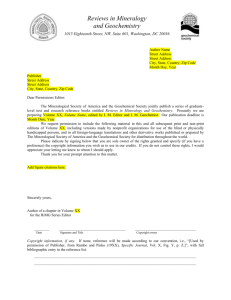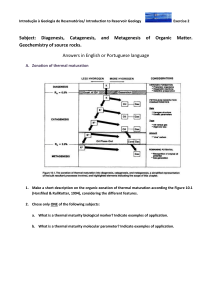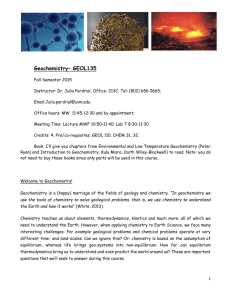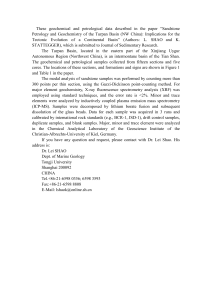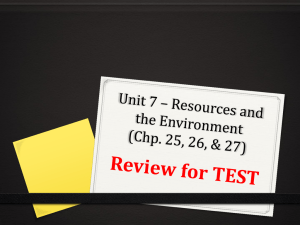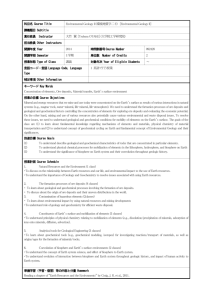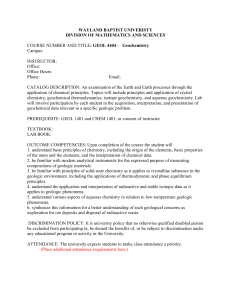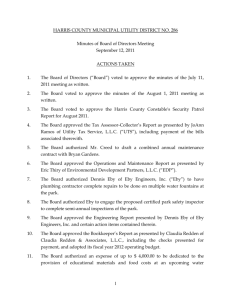GEOL 310: Environmental Geochemistry
advertisement
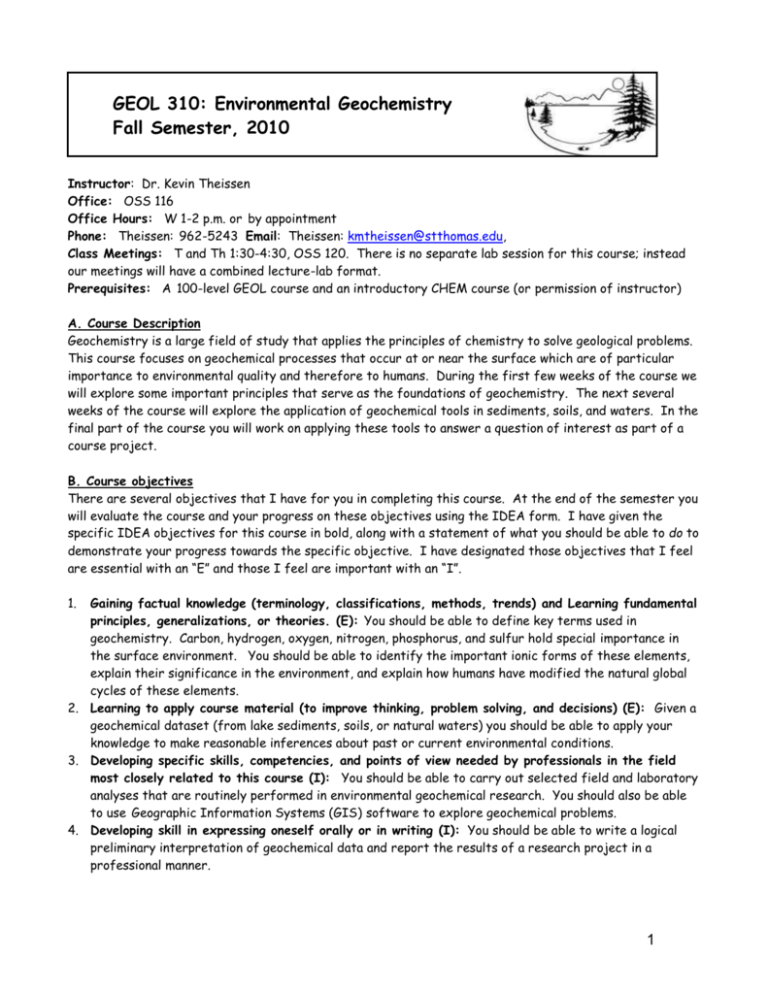
GEOL 310: Environmental Geochemistry Fall Semester, 2010 Instructor: Dr. Kevin Theissen Office: OSS 116 Office Hours: W 1-2 p.m. or by appointment Phone: Theissen: 962-5243 Email: Theissen: kmtheissen@stthomas.edu, Class Meetings: T and Th 1:30-4:30, OSS 120. There is no separate lab session for this course; instead our meetings will have a combined lecture-lab format. Prerequisites: A 100-level GEOL course and an introductory CHEM course (or permission of instructor) A. Course Description Geochemistry is a large field of study that applies the principles of chemistry to solve geological problems. This course focuses on geochemical processes that occur at or near the surface which are of particular importance to environmental quality and therefore to humans. During the first few weeks of the course we will explore some important principles that serve as the foundations of geochemistry. The next several weeks of the course will explore the application of geochemical tools in sediments, soils, and waters. In the final part of the course you will work on applying these tools to answer a question of interest as part of a course project. B. Course objectives There are several objectives that I have for you in completing this course. At the end of the semester you will evaluate the course and your progress on these objectives using the IDEA form. I have given the specific IDEA objectives for this course in bold, along with a statement of what you should be able to do to demonstrate your progress towards the specific objective. I have designated those objectives that I feel are essential with an “E” and those I feel are important with an “I”. 1. Gaining factual knowledge (terminology, classifications, methods, trends) and Learning fundamental principles, generalizations, or theories. (E): You should be able to define key terms used in geochemistry. Carbon, hydrogen, oxygen, nitrogen, phosphorus, and sulfur hold special importance in the surface environment. You should be able to identify the important ionic forms of these elements, explain their significance in the environment, and explain how humans have modified the natural global cycles of these elements. 2. Learning to apply course material (to improve thinking, problem solving, and decisions) (E): Given a geochemical dataset (from lake sediments, soils, or natural waters) you should be able to apply your knowledge to make reasonable inferences about past or current environmental conditions. 3. Developing specific skills, competencies, and points of view needed by professionals in the field most closely related to this course (I): You should be able to carry out selected field and laboratory analyses that are routinely performed in environmental geochemical research. You should also be able to use Geographic Information Systems (GIS) software to explore geochemical problems. 4. Developing skill in expressing oneself orally or in writing (I): You should be able to write a logical preliminary interpretation of geochemical data and report the results of a research project in a professional manner. 1 C. Textbook and other readings I have asked you to purchase the following textbook: Eby, G.N., 2004. Principles of Environmental Geochemistry. Brooks/Cole, California, 514 p. This is a good reference and many of the problems we will work on in the course are drawn from it. The book is available through the bookstore (although you will get a better price online!!). Other good sources of information I will provide type-written notes for most of our meeting sessions. I have developed my notes and lecture materials from your text along with several other useful sources of information listed below. In some cases I have assigned outside readings which I will provide for you either with hardcopies or through online access on the Blackboard site. Harte, J., 1988. Consider a Spherical Cow: A Course in Environmental Problem Solving. William Kaufmann, Inc., California, 283 p. Faure, G., 1998. Principles and Applications of Geochemistry (2nd ed.). Prentice Hall, New Jersey, 600 p. Schleshinger, W.H., 1997. Biogeochemistry: An Analysis of Global Change (2 nd ed.). Academic Press, New York, 588 p. Smol, J.P., 2008. Pollution of Lakes and Rivers (2 nd ed.) Blackwell, 383 p. White, W. M., 2009. Geochemistry. (online) D. Grading (this grading scheme is subject to changes) This is a 300-level course and I expect you to be prepared for class sessions and that you will produce high-quality work. That said, I realize that you all have varying levels of experience in geology and chemistry and will work with you to help you get the most out of this course. The breakdown for grading is as follows: Item % of grade Course research project (paper and presentation) 30% Midterm Exam and quiz 20% Lab activities 20% Homework, in-class problem-solving 15% Presentation on an env. geochemical topic of interest 10% Participation (including attendance, knowledge surveys) 5% Totals 100% Homework and in-class activities (including lab activities) In order to keep up with the material we are covering in this course you will regularly be expected to complete homework and in-class assignments. Homework will take the form of weekly problem sets (+/-) during the first half of the course. I do not mind if you work together on homework problems, but you must write up your own answers and express yourself in your own words. 2 Lab activities Lab activities are designed for you to get hands-on experience in the collection, analysis, and data interpretation involved in environmental geochemistry. For these activities you will often work with others and the focus will be on building skills. Some of these activities will be graded during the lab with the instructor checking-off your completion of tasks and giving you immediate feedback. Others may call for you to contribute in a team effort to collect data that we later discuss as a group. Course Project In the final third of the course you will work with a partner to come up with an environmental question of interest and to apply one or more of the geochemical tools used in this course to explore your question. You will produce a report (written in scientific paper style) on your results and present your findings to your classmates during the final week of the course. The project constitutes the largest portion of your grade and I will expect that you put considerable work into it. Accordingly, I have carved out time during the last several weeks for you to work on the project and consult with me on your progress. Grading for the projects will be based on a rubric that I have designed and will give you at the onset of the project. Take-home Midterm exam and quiz You will complete a take-home format mid-term exam (15% of grade) at roughly the halfway point in the course. On this exam you may use your text and class notes but you will be required to work individually. I will also give an in-class quiz (5% of grade) later on in the course to make sure you are keeping up with reading and lecture materials. There will be no final exam for the course. Presentation on an environmental geochemical topic of interest Beginning in the 6th week of the course you will be giving individual presentations on select environmental problems that involve geochemistry. The objective of this exercise if for you to explore an environmental problem of interest in greater depth and to get practice explaining the most important points about it in a clear and concise manner. A second important objective is for you to get practice speaking to your peers prior to your project presentation so that I can give you some useful feedback. Grading for the projects will be based on a rubric that I have designed and will give you as you begin planning this presentation. Example topics: acid mine drainage, acid rain, asbestos contamination, radon in the home, oil spill contamination, ozone destruction, impact of changing pH on marine organisms, marine “dead zones”. Participation, including regular attendance and knowledge survey completion I will evaluate your contribution, effort, and attitude throughout the course. In order to evaluate your learning in this course, I will ask you to complete two Knowledge Surveys (one in the first class meeting and another in the last class meeting). More details on this in class. *In compliance with the University of St. Thomas policy and disability laws, I am available to discuss academic accommodations that you may require as a student with a disability. Students are encouraged to register with the Enhancement Program-Disability Services office for disability verification and for determination of academic accommodations. Appointments can be made by calling 651-962-6315 or 800328-6819, extension 6315. Telephone appointments are available as needed. You may also make an appointment in O’Shaughnessy Educational Center, room 119. For further information, you can locate the Enhancement Program on the web at http://www.stthomas.edu/enhancementprog/. 3 E. Tentative Course Schedule. This schedule is subject to change Week,Dates Topics Activities Week 1 Introduction, the elements, periodic table, Units review Sept 9 nucleosynthesis Knowledge survey Reading Eby: Chapter 1 (p. 1-18) Week 2 Sept 14, 16 Exploring environmental data with GIS Water chemistry and significance, Geochemical models GIS exercise #1 (with hydrogeology) Eby: Chapter 1 (p. 18-23) Week 3 Sept 21 Week 4 Sept 28, 30 Equilibrium thermodynamics No class on Sept 23 Acids and bases The carbonate system and alkalinity Lakes as environmental “beakers” Principles of oxidation and reduction (guest instructor, Dr. Jennifer McGuire) TBA Eby: Chapter 2 (p. 27-42) Lake sampling trip, (tentatively Sept 30) Alkalinity titrations Cedar Creek trip (tentatively Oct 7) Eby: Chapter 3 (p. 59-75 ) Eby: Chapter 3 (pp. 75-90) Carbon chemistry and sedimentary geochemical indicators: elemental tracers (C, N), molecular fossils *Topical presentations begin Radioactive isotopes and their use as “clocks” and environmental tracers Take-Home mid-term exam Stable isotopes and their many applications GIS exercise #2 C/N analysis Eby: Chapter 5 GIS exercise #2 (cont.) Age-dating exercise Interpreting lake Elemental and Isotopic records Measuring nitrate, spectrophotometry Eby: Chapter 6 (p 165-181) “Radiocarbon, a unique tracer” Paper (blackboard) Eby: Chapter 6 (p 181-194) Week 5 Oct 5, 7 Week 6 Oct 12, 14 Week 7 Oct 19, 21 Week 8 Oct 26, 28 Week 9 Nov 2, 4 Week 10 Nov 9, 11 Week 11 Nov 16, 18 Week 12 Nov 23 Week 13 Nov 30 Dec 2 Week 14 Dec 7, 9 Nitrogen and Phosphorus cycles Nitrogen and phosphorus in the environment Eutrophication of lakes and “dead zones” (guest speaker, Dr. Will Hobbs, SCWRS) Sulfur in the environment Eby: Chapter 4 (p 94-110) W. Schlesinger reading, J. Smol reading Elemental analysis by ICP-AES Mercury and other metals in the environment Project working time (guest speaker, Dr. Edward Swain, MPCA) W. Schlesinger reading Greenhouse gases and global climate change *Topical presentations end Geochemical applications in global climate change: paleothermometry Project working time Eby: Chapter 8 (p 253-262) Project working time Eby: Chapter 6 (197-198) Additional reading TBA Project presentations and course wrap-up Project presentations Knowledge survey Eby: Chapter 9 (p 350-364) 4
